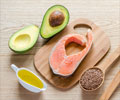- Polyunsaturated fatty acids (PUFA) are good fats which possess numerous health benefits. Vegetable oils, seeds, nuts and sea food are rich in PUFA.
- Early adults aged between 18 - 35 experienced changes in appetite hormones associated with hunger and satiety after following a PUFA-rich diet.
- Foods which reduce hunger or increase satiety influenced by hormones could ultimately play a role in achieving optimal body weight.
PUFA Influences Hunger Hormones and Satiety
One gram of fat provides 9kcal and is more satiating than proteins or carbs. But fat-rich foods can sometimes mislead us into overeating as they tend to be more palatable. Choosing between the good fats that provide energy to the body, as well as make the body feel full can help in weight loss and weight management.
Fat plays a role in weight management when the effect of the food is exhibited on the hormones that regulate hunger and satiety. Appetite -- the feeling of hunger and satiety -- and the feeling of fullness after we eat are influenced by two main hormones, leptin and ghrelin.
"Appetite hormones play an important role in regulating how much we eat," said lead researcher, Jamie A. Cooper, PhD of the University of Georgia.
Polyunsaturated fat can be found mostly in nuts, seeds, fish, seed oils, and oysters. The types of PUFA present in these are omega-3 fatty acid and omega-6 fatty acid.
Fish, tuna, salmon, fish oils, sea food like oyster are rich in omega-3-fats.
Measuring Hormone Changes after a PUFA-rich Meal
The study conducted among 26 healthy men and women (aged 18-35) looked at physiological hunger and satiety responses by measuring hormone changes. Subjective ratings, by asking participants to indicate on a scale how hungry or full they were and how much they thought they could eat, were also assessed.
The subjects were either on a seven-day diet high in PUFAs or a control diet consisting of a typical American eating pattern, high in saturated fat.
Both the PUFA-rich diet and the typical American diet had the same number, percentage of calories derived from fat but differed in the types of fat included.
The control diet comprised 7% polyunsaturated fat, 15% monounsaturated fat and 13% saturated fat, while the PUFA-rich diet had 21% polyunsaturated fat, 9% monounsaturated fat and 5% saturated fat.
All meals were provided by the researchers. After the seven-day diet, participants consumed test meals high in saturated fat, once again.
Walnuts, Alaska salmon, tuna, flaxseed oil, grapeseed oil, canola oil, and fish oil supplements were part of the PUFA-rich diet.
Walnuts primarily comprise PUFAs, with 13gms of PUFA out of 18 grams of total fat per one ounce serving. As a result, walnut is the only nut to contain a significant amount of plant-based omega-3 alpha-linolenic acid (ALA) (2.5 grams per one ounce).
Study Findings
The 2015-2020 Dietary Guidelines for Americans has recommended the substitution of PUFA with saturated fats owing to the range of health benefits offered by the PUFAs.
The recent study finds that the PUFA-rich diet
- Lowered fasting ghrelin levels, a hormone that increases hunger.
- Increased peptide YY (PYY) a hormone that increases fullness or satiety while fasting and after consuming a meal.
- These types of hormone changes imply better appetite control and facilitates weight control by controlling overeating.
- There were no changes in the subjective ratings - the sensations of hunger and fullness in either the PUFA-rich diet or the control diet.
Study Limitations
In order to clarify the results, larger and longer-term studies, as well as studies in diverse populations, are needed.
The results of the study could be attributed to one specific type of PUFA, food source, or a combination of overall dietary factors. It is difficult to discern the changes in the context of a whole food diet. More clinical trials are needed to determine the optimal intake of dietary PUFAs to offer the greatest health benefits.
Reference:
- Stevenson JL, Paton CM, Cooper JA. Hunger and satiety responses to high-fat meals after high polyunsaturated fat diet: a randomized trial. Nutrition. DOI: http://dx.doi.org/10.1016/j.nut.2017.03.008
















